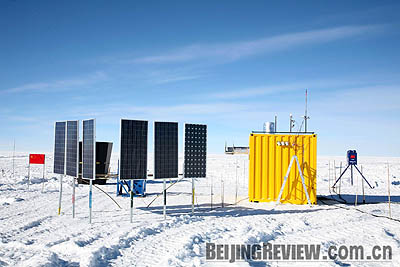|

POLAR MONITORING: A Chinese wireless sensor network on Dome A, the highest polar icecap peak in Antarctic at 4,093 meters above sea level
ZHU ZHENXI
China will complete the construction of its first inland Antarctic research station at Dome A, the highest polar icecap peak at 4,093 meters above sea level, next year, according to a south pole scientist involved in the project.
"The preparatory work for the new station is underway," Sun Bo, captain of the Icecap Research Squad of the 24th Chinese Antarctic Expedition Team, told Xinhua News Agency in a recent interview. Sun spent four months in Antarctic between December 2007 and this March.
"The 25th Antarctic expedition that will start in this November is tasked with building the main structure of the station on Dome A, which is expected to be complete next January," Sun noted.
The new research station will be China's third research base in Antarctic after the Great Wall and Zhongshan stations.
Dome A, located at 80 degrees 22 minutes south latitude and 77 degrees 22 minutes east longitude, is the highest area of the Antarctic inland icecap, is generally recognized as the best place in Antarctic for setting up an observatory. It will be of great significance for research on global climate change through long-term scientific observation.
Chinese scientists visited other Antarctic inland stations including the U.S. Amundsen-Scott South Pole Station and the Japanese Dome Fuji Station before planning their new base in the south pole region.
They also visited the new Belgian Princess Elisabeth Station when it was exhibited in Brussels before being shipped to Antarctic, and learned much about the Franco-Italian Concordia (Dome C) Station and Britain's Halley Station.
"Visits to these inland stations help us learn from others, so that we can design the new Chinese station by building on their experience," said Qu Tanzhou, Director of the Chinese Arctic and Antarctic Administration (CAAA) responsible for steering Chinese policy and scientific activities in polar regions.
"We are working very hard to apply strict safety and environmental principles. For example, in order to reduce the workload and the impact on the environment, adapted containers have been selected as the main structure of the new station," Qu added.
The construction of the new station will be a phased process. The first one will be the building of a summer-only station using modified and specially adapted containers. Then scientists plan to keep building and improving the station in order to turn it into an all-year station within 10 years.
"In order to overcome logistical problems relating to supply and transport of personnel, we are planning to commission a specially adapted plane that will be built in China in the future," Qu explained. "But in the meantime, we are exploring the possibility of using Australian air support to transport some of our goods and personnel to and from Dome A."
According to Qu, the main task at Dome A will be deep ice core drilling, glaciology, astronomy, atmospheric science, weather observation, and also studying the geology of the Gamburtsev mountain range that lies beneath the ice cap under Dome A.

WELCOME HOME: Members of China’s 24th Antarctic Expedition Team arrive in Shanghai on April 15, after completing their 156-day mission PEI XIN
In addition, China will also continue transect investigations and observations between Zhongshan Station and Dome A, including continued surveying.
Longest journey
The 24th Chinese Antarctic Expedition Team, which left Shanghai on November 12, 2007, completed 37 scientific studies and 10 logistic programs despite encountering rough seas and severe snowstorms in Antarctic. The researchers' efforts helped the 24th mission surpass all previous ones in the number of fulfilled tasks.
The mission also saw the Xue Long (Snow Dragon) icebreaker break several records as the Chinese vessel experienced its longest Antarctic journey with its heaviest load-28,450 sea miles in total.
The team collected over 3,000 samples and some 10 gigabytes of data, according to Wei Wenliang, CAAA Deputy Director.
In January, Chinese scientists made mankind's second visit to Dome A, following the first-ever successful ascent in January 2005. They chose a location for the astronomical observatory at Dome A, installed a wireless sensor network, conducted earthquake observation on the inland icecap, drafted a topographic chart with the scale of 1:50000, and carried out physiological and psychological tests on expedition team members.
The wireless sensor network can collect the parameters of temperature, humidity and air pressure, and will send them back to the research center in Beijing via satellite communication. The batteries of the network are expected to last at least one year, according to Sun.
A construction team from the China Railway Construction Engineering Group has finished the groundwork of the biggest ever renovation and expansion of Zhongshan Station. They will head back to the station for the next phase of the construction project this October, said Liu Dubin, Project Manager.
The construction work has consumed 200 cubic meters of sand and stone and more than 60 tons of cement, which were carried to the Antarctic from China as Antarctic sand is not suitable for construction, said Liu.
"We have to use special material to build houses there. The concrete has to be antisepticised, and the wood and the groundsill have to be as deep as 2 meters," Liu said, adding that the buildings should be able to stand a 14-level strong gale.
Scientific strength
Scientific research in polar regions is central to understanding the planet, the mechanisms that drive it, and the changes that affect it. China is now stepping up its investment in both Arctic and Antarctic science-putting to good effect its rapid economic growth, and also embracing the International Polar Year 2007-08.
With its Yellow River Station in Svalbard in Arctic and the two stations in Antarctica, China has been quietly involved in polar research since the early 1980s.
In 2006, the Chinese Government boosted its commitment to this field of science by allocating an additional $70 million in funding to the Polar Research Institute of CAAA.
The station at Dome A will also be a platform for international cooperation, according to Qu. "Conditions permitting, we are very willing to cooperate with countries that have similar interests as us, but because we still have a lot to transport to Dome A for the construction of the station, this kind of collaboration will be difficult for the next few years," he said. "In the future, however, we will try our best to facilitate this kind of cooperation."
He said that interest has already been expressed by South Korea, Japan, France, Germany and Australia, but logistics are binding and some science projects, such as deep ice core drilling, take years to develop. They cannot be deployed at short notice. | 